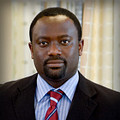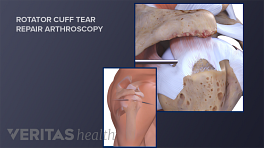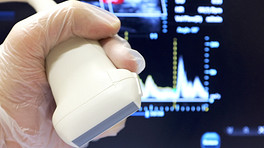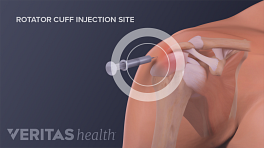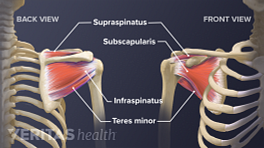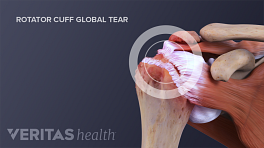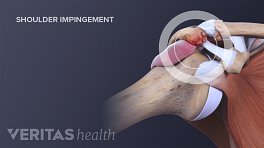Most people report improved shoulder strength and reduced pain after rotator cuff surgery, 1 Rotator Cuff Tears: Surgical Treatment Options. American Academy of Orthopedic Surgeons website. http://orthoinfo.aaos.org/topic.cfm?topic=a00406 Last reviewed May 2011. Accessed April 20, 2016. but a small portion of rotator cuff surgery patients experience complications.
See Rotator Cuff Repair Surgery
Possible surgical complications include:
- In general, surgery involving anesthesia, which includes rotator cuff surgery, poses a slight risk of stroke, heart attack, pneumonia, or blood clot.
- Damage to adjacent nerves and blood vessels. One study found that 1 to 2% of patients going through rotator cuff surgery experience nerve damage. 2 Boardman ND, Cofield RH. Neurologic complications of shoulder surgery. Clin Orthop Relat Res. 1999; 368: 44-53.
- Infection in the shoulder. Only 0.16 to 1.9% of patients cited deep infection after arthroscopic or mini-open surgery. 4 Vastamäki H, Vastamäki M. Postoperative stiff shoulder after open rotator cuff repair: A 3- to 20-year follow-up study. Scandinavian Journal of Surgery. 2013; 0: 1-8.
- Stiffness is common after rotator cuff surgery. A retrospective study of 103 postoperative patients found that 20% experienced stiffness following open rotator cuff operation; stiffness ended in 6 to 12 months after surgery with positive outcomes. 4 Vastamäki H, Vastamäki M. Postoperative stiff shoulder after open rotator cuff repair: A 3- to 20-year follow-up study. Scandinavian Journal of Surgery. 2013; 0: 1-8.
Occasionally, patients tear their repairs. The chance of this occurring increases with the size of the original tear.
In This Article:
- Rotator Cuff Tear Surgery
- Who Can Have Rotator Cuff Surgery?
- What to Do Before Rotator Cuff Surgery
- Different Types of Rotator Cuff Surgery
- Rotator Cuff Surgery Recovery
- Rotator Cuff Surgery Risks and Complications
Factors That Impact Rotator Cuff Surgery Rehabilitation:
There are certain factors that influence the recovery from rotator cuff surgery. These include:
- Surgical approach. There are several surgical methods used to treat a rotator cuff injury: open surgery, arthroscopic, or a combination of the two. While each option can effectively treat the patient, an arthroscopic procedure involves considerably less pain after the surgery. 5 Ghodadra NS, Provencher MT, Verma NN, Wilk KE, Romeo AA. Open, Mini-open, and All-Arthroscopic Rotator Cuff Repair Surgery: Indications and Implications for Rehabilitation. Journal of Orthopaedic & Sports Physical Therapy. 2009; 39: 81-89.
- Tendon tear size. It is generally agreed that smaller tears have better outcomes than larger ones—those greater than 5 cm. 5 Ghodadra NS, Provencher MT, Verma NN, Wilk KE, Romeo AA. Open, Mini-open, and All-Arthroscopic Rotator Cuff Repair Surgery: Indications and Implications for Rehabilitation. Journal of Orthopaedic & Sports Physical Therapy. 2009; 39: 81-89.
- Tissue quality. Tissue quality varies between patients, and can be evaluated on preoperative magnetic resonance imaging (MRI) scan prior to surgery. Knowing the tissue quality influences patient rehabilitation.
- Location and type of tear. Tears affecting the backside portion of the shoulder demand more care and limited shoulder rotation motion.
- Rehabilitation method. Rehabilitation is critical to a patient’s success following rotator cuff surgery. Patients using a proficient physical therapist show substantially more improvement than those helped by home therapy programs, one paper clinically observed. 5 Ghodadra NS, Provencher MT, Verma NN, Wilk KE, Romeo AA. Open, Mini-open, and All-Arthroscopic Rotator Cuff Repair Surgery: Indications and Implications for Rehabilitation. Journal of Orthopaedic & Sports Physical Therapy. 2009; 39: 81-89.
- Patient factors. Age, activity level, lifestyle choices, occupation, and hobbies may reflect rehabilitation from rotator cuff surgery.
- Several authors have found that older patients, those older than 65 years old, have less successful postoperative outcomes.
- Healing time is affected by health conditions like diabetes mellitus or whether or not the patient smokes.
- According to one study, patients with worker’s compensation double the time to return to work compared to other rotator cuff patients. 5 Ghodadra NS, Provencher MT, Verma NN, Wilk KE, Romeo AA. Open, Mini-open, and All-Arthroscopic Rotator Cuff Repair Surgery: Indications and Implications for Rehabilitation. Journal of Orthopaedic & Sports Physical Therapy. 2009; 39: 81-89.
- A patient’s activity level prior to surgery is often indicative of activity level following surgery.
Above all, both the patient and physician have a role in the recovery of the rotator cuff.
What If Rotator Cuff Surgery Does Not Work?
While rotator cuff surgeries can have positive, lasting results, not all surgical repairs heal. 6 Abtahi AM, Granger EK, Tashjian RZ. Factors affecting healing after arthroscopic rotator cuff repair. World Journal of Orthopedics. 2015;6(2):211-220. doi:10.5312/wjo.v6.i2.211. When rotator cuff repair is unsuccessful, a patient experiences postoperative pain and/or shoulder stiffness. These patients may choose to have a second surgery.
For example:
- A second repair may be done if sufficient quality and quantity of tissue remain.
- A surgical release of scar tissue can improve the patient’s range of motion.
Second repair surgeries—sometimes called “revision surgeries—can be technically challenging and generally have lower success rates than original repair surgeries. 7 Djurasovic M, Marra G, Arroyo JS, Pollock RG, Flatow EL, Bigliani LU. Revision rotator cuff repair: factors influencing results. J Bone Joint Surg Am. 2001; 83: 1849-1855.
Many second repair surgeries reduce pain, but they are less likely to improve shoulder function. Improved functional outcomes are mostly seen in patients who: 7 Djurasovic M, Marra G, Arroyo JS, Pollock RG, Flatow EL, Bigliani LU. Revision rotator cuff repair: factors influencing results. J Bone Joint Surg Am. 2001; 83: 1849-1855.
- Have healthy, intact deltoid muscles at the top of the shoulder.
- Were able to raise the arm preoperatively “above the horizontal,” or when the arm is at 90 degrees or greater as found in swimming and throwing sports, for example. 8 Jain NB, Wilcox R, Katz JN, Higgins LD. Clinical Examination of the Rotator Cuff. PM & R : the journal of injury, function, and rehabilitation. 2013;5(1):10.1016/j.pmrj.2012.08.019. doi:10.1016/j.pmrj.2012.08.019. And O’Connor FG. Musculoskeletal and Sports Medicine for the Primary Care Practitioner Fourth Edition. Boca Raton, FL: CRC Press; 2016.
- Have rotator cuff tissue of decent quality (more likely in patients who have experienced a shoulder injury than degenerative tears).
- Had only one surgical procedure before the repair.
Second repairs to large tears are generally less likely to be successful. 9 Gilot GJ, Attia AK, Alvarez AM. Arthroscopic repair of rotator cuff tears using extracellular matrix graft. Arthrosc Tech. 2014;3(4):e487-9.
- 1 Rotator Cuff Tears: Surgical Treatment Options. American Academy of Orthopedic Surgeons website. http://orthoinfo.aaos.org/topic.cfm?topic=a00406 Last reviewed May 2011. Accessed April 20, 2016.
- 2 Boardman ND, Cofield RH. Neurologic complications of shoulder surgery. Clin Orthop Relat Res. 1999; 368: 44-53.
- 4 Vastamäki H, Vastamäki M. Postoperative stiff shoulder after open rotator cuff repair: A 3- to 20-year follow-up study. Scandinavian Journal of Surgery. 2013; 0: 1-8.
- 5 Ghodadra NS, Provencher MT, Verma NN, Wilk KE, Romeo AA. Open, Mini-open, and All-Arthroscopic Rotator Cuff Repair Surgery: Indications and Implications for Rehabilitation. Journal of Orthopaedic & Sports Physical Therapy. 2009; 39: 81-89.
- 6 Abtahi AM, Granger EK, Tashjian RZ. Factors affecting healing after arthroscopic rotator cuff repair. World Journal of Orthopedics. 2015;6(2):211-220. doi:10.5312/wjo.v6.i2.211.
- 7 Djurasovic M, Marra G, Arroyo JS, Pollock RG, Flatow EL, Bigliani LU. Revision rotator cuff repair: factors influencing results. J Bone Joint Surg Am. 2001; 83: 1849-1855.
- 8 Jain NB, Wilcox R, Katz JN, Higgins LD. Clinical Examination of the Rotator Cuff. PM & R : the journal of injury, function, and rehabilitation. 2013;5(1):10.1016/j.pmrj.2012.08.019. doi:10.1016/j.pmrj.2012.08.019. And O’Connor FG. Musculoskeletal and Sports Medicine for the Primary Care Practitioner Fourth Edition. Boca Raton, FL: CRC Press; 2016.
- 9 Gilot GJ, Attia AK, Alvarez AM. Arthroscopic repair of rotator cuff tears using extracellular matrix graft. Arthrosc Tech. 2014;3(4):e487-9.
